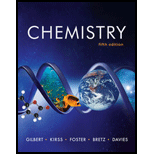
Concept explainers
(a)
Interpretation: The values of
Concept introduction: The compound
To determine: The values of
(a)
Answer to Problem 3.125AP
Solution
The value of
Explanation of Solution
Explanation
Given
The mass percent of uranium in
The mass percent of oxygen in
The number of moles of the given element is calculated by using the formula,
Substitute the values of mass and molar mass of uranium in the equation (1).
Substitute the values of mass and molar mass of oxygen in the equation (1).
The calculated values are divided by the smallest number of moles to determine the simplest whole number ratio of moles of each constituent,
For uranium
For oxygen
Therefore, the formula of given compound is
The charge on the uranium in
Substitute the values of charge on oxygen and molecule in the above equation.
Thus, the value of
(b)
To determine: The values of
(b)
Answer to Problem 3.125AP
Solution
The value of
Explanation of Solution
Explanation
Given
The mass percent of uranium in
The mass percent of oxygen in
The number of moles of the given element is calculated by using the formula,
Substitute the values of mass and molar mass of uranium in the equation (1).
Substitute the values of mass and molar mass of oxygen in the equation (1).
The calculated values are divided by the smallest number of moles to determine the simplest whole number ratio of moles of each constituent,
For uranium
For oxygen
The numbers obtained are multiplied with
The charge on the uranium in
Substitute the values of charge on oxygen and molecule in the above equation.
Thus, the value of
(c)
To determine: The values of
(c)
Answer to Problem 3.125AP
Solution
The value of
Explanation of Solution
Explanation
Given
The compound
The mass of compound
The mass of
The mass of uranium oxide in the reaction is
The reaction involving the decomposition of
The mass of water in the reaction is calculated by subtracting the mass of
The compound
The mass of nitrogen oxides and oxygen in the reaction is calculated by subtracting the mass of
Since, the nitrogen and oxygen are present in
For nitrogen
For oxygen
The mass of uranium and oxygen in
For uranium
For oxygen
The total mass of oxygen in the given compound is,
The number of moles of the given element is calculated by using the formula,
Substitute the values of mass and molar mass of uranium in the equation (1).
Substitute the values of mass and molar mass of oxygen in the equation (1).
Substitute the values of mass and molar mass of nitrogen in the equation (1).
Substitute the values of mass and molar mass of water in the equation (1).
The calculated values are divided by the smallest number of moles to determine the simplest whole number ratio of moles of each constituent,
For uranium
For oxygen
For nitrogen
For water
Therefore, the formula of given compound is
Conclusion
The value of
The value of
The value of
Want to see more full solutions like this?
Chapter 3 Solutions
Smartwork5 Printed Access Card for Use with Chemistry: The Science in Context 5th Edition (SmartWork Access Printed Access Card)
 ChemistryChemistryISBN:9781305957404Author:Steven S. Zumdahl, Susan A. Zumdahl, Donald J. DeCostePublisher:Cengage Learning
ChemistryChemistryISBN:9781305957404Author:Steven S. Zumdahl, Susan A. Zumdahl, Donald J. DeCostePublisher:Cengage Learning ChemistryChemistryISBN:9781259911156Author:Raymond Chang Dr., Jason Overby ProfessorPublisher:McGraw-Hill Education
ChemistryChemistryISBN:9781259911156Author:Raymond Chang Dr., Jason Overby ProfessorPublisher:McGraw-Hill Education Principles of Instrumental AnalysisChemistryISBN:9781305577213Author:Douglas A. Skoog, F. James Holler, Stanley R. CrouchPublisher:Cengage Learning
Principles of Instrumental AnalysisChemistryISBN:9781305577213Author:Douglas A. Skoog, F. James Holler, Stanley R. CrouchPublisher:Cengage Learning Organic ChemistryChemistryISBN:9780078021558Author:Janice Gorzynski Smith Dr.Publisher:McGraw-Hill Education
Organic ChemistryChemistryISBN:9780078021558Author:Janice Gorzynski Smith Dr.Publisher:McGraw-Hill Education Chemistry: Principles and ReactionsChemistryISBN:9781305079373Author:William L. Masterton, Cecile N. HurleyPublisher:Cengage Learning
Chemistry: Principles and ReactionsChemistryISBN:9781305079373Author:William L. Masterton, Cecile N. HurleyPublisher:Cengage Learning Elementary Principles of Chemical Processes, Bind...ChemistryISBN:9781118431221Author:Richard M. Felder, Ronald W. Rousseau, Lisa G. BullardPublisher:WILEY
Elementary Principles of Chemical Processes, Bind...ChemistryISBN:9781118431221Author:Richard M. Felder, Ronald W. Rousseau, Lisa G. BullardPublisher:WILEY





